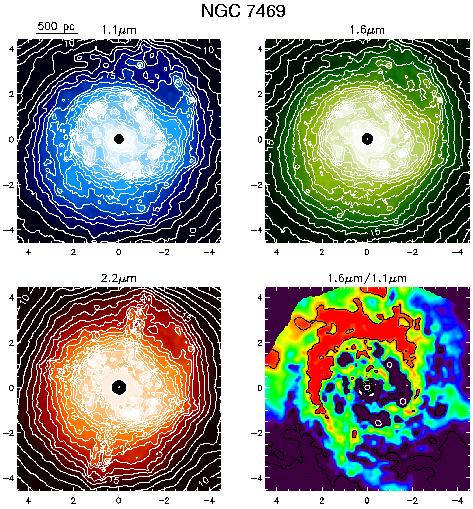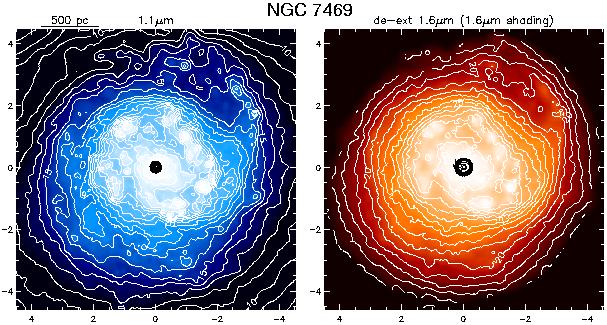


The near-infrared emission from NGC 7469 is dominated by the bright,
point-like Seyfert nucleus point-source. However, the bright inner disk
of the galaxy has been seen in much earlier optical (De Robertis & Pogge
1986, Wilson et al. 1986) and near-infrared (Mazzarella et al. 1994)
imaging, and is
discussed extensively in Genzel et al. (1995). A short spiral arm-like
feature in the NW are clearly seen in the point-source subtracted images.
(The bright linear SSE-NNW feature is a PSF
artifact which we were unable to remove in the 2.2 µm
image.) In the
inner disk, there is a ring of star formation at ~ 1" radius,
corresponding to 500 pc. The structure within the ring is similar in all
three bands and is well outside the area in which residual PSF should
introduce structure. This starburst disk is very similar to that seen in
NGC 1068; in NGC 7469 there is no evidence of a bar like that
seen in NGC 1068. The secondary companion to NGC 7469,
IC 5283 is 80" (26 kpc)
away and therefore well outside the field of our images. The data for this
galaxy will be discussed more thoroughly in Thompson et al. (1999).
Shaded contour plots of the extinction corrected
2.2 µm emission are shown together with the 1.1
µm (upper left)
observed emission. In both panels, the contours and shading are
logarithmic with the contours spaced by factors 21/2. (The level
values are the same as for the figure above). The arcsec displacements
in RA and DEC, given along the borders are measured from the 2.2
µm in
all frames. At the upper left, a length bar is drawn. For the ratio image,
both the 2.2 and 1.1 µm images were smoothed with the same adaptive
smoothing and then smoothed with a Gaussian FWHM = 0.2" in
calculating the 2.2 µm opacity from Eq. 3 (see text). In
cases where a
strong point-source or variable background contaminated the 2.2 µm
image, the extinction corrected image was derived for 1.6
µm. For the
galaxies with strong point-sources, the PSF was fit to the source and then
subtracted and replaced by a Gaussian with the proper integrated flux (see
text - NGC 7469, IRAS 08572+3915, IRAS 05189-2524, PKS 1345+12, IRAS 07598+6508, Mrk 1014 and 3C48).


